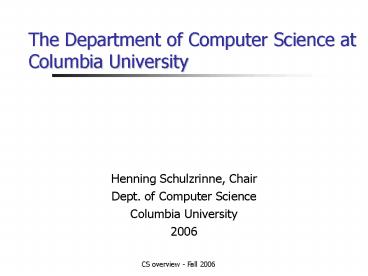The Department of Computer Science at Columbia University - PowerPoint PPT Presentation
1 / 14
Title:
The Department of Computer Science at Columbia University
Description:
New Security Projects. Joint with Steve Bellovin, Angelos Keromytis, Gail Kaiser, Moti Yung, ... NSL Projects. Self-healing software ... – PowerPoint PPT presentation
Number of Views:52
Avg rating:3.0/5.0
Title: The Department of Computer Science at Columbia University
1
The Department of Computer Science at Columbia
University
- Henning Schulzrinne, Chair
- Dept. of Computer Science
- Columbia University
- 2006
2
Computer/Network Security
- 4 Faculty (Bellovin, Keromytis, Stolfo, Yung),
and 4 affiliated faculty (Kaiser, Nieh, Misra,
Schulzrinne) - 15 GRAs
- Spanning a range of security research issues
Network security host-based security insider
attacks - Applied security research
- Build system, test against real data, deploy to
other organizations for validation - Sponsors include NSF, DARPA, ARO, DTO (formerly
ARDA)
3
Columbia Intrusion Detection Lab (Sal Stolfo)
- Attackers continue to improve techniques
undeterred - Present COTS security defenses are porous and
suffer from the false negative proble - Attackers are clever, evading detection using
many forms of stealth - There is no one monolithic security solution
security is a design criteria at all layers of
the stack and across multiple sites - Behavior-based computer security will
substantially raise the bar - Columbia conducts a broad spectrum of research
related to securing critical infrastructure in
close collaboration with industry and government
with attention to practical and deployable
results - Eg., Financial Systems Technology Consortium
(fstc.org) Security Standing Committee (SSCOM) is
hosted at Columbia CS - Visit http//www.cs.columbia.edu/faculty
- http//www.cs.columbia.edu/ids
4
Columbia Intrusion Detection Lab Anomaly
Detection for Zero-Day Attack
- AEOLOS
- Privacy-preserving Cross Domain Content Alert
Sharing infrastructure - Detection of targeted attacks against critical
domains - Anagram Content-based Anomaly Detection
- Behavior-based detection of abnormal data
- Zero-day exploits detected on host
- EMT Email Mining Toolkit
- Forensic analysis of email logs for profile and
model generation - Social Network Analysis
5
New Security Projects
- Joint with Steve Bellovin, Angelos Keromytis,
Gail Kaiser, Moti Yung, - FSTC cooperative project Authenticating
Financial Institution to Customer on the web - Collaborative Security and Self-healing Systems
(new NSF Cybertrust grant) - Application communities
- Large-Scale System Defense (new DTO grant)
- BARTER Behavior-based Access Control (new DARPA
grant) - Insider Attack and Masquerader Detection (new ARO
grant) - Counter Evasion Techniques
6
Network Security LabProf. Angelos D. Keromytis
- Applied research in security, networking,
operating systems - Emphasis on systems and on building stuff
- Main research projects
- Self-healing software and software security
- Application on countering network viruses/worms
- Network denial of service
- Currently 6 Ph.D. students (Cook, Locasto,
Burnside, Stavrou, Sidiroglou, Androulaki) - Closely affiliated faculty Stolfo, Bellovin,
Kaiser, Yung - http//nsl.cs.columbia.edu/
7
NSL Projects
- Self-healing software
- Enable legacy software to learn from its failures
and improve itself over time, without human
intervention! - Network Worm Vaccine
- Limit worm infection rate via anomaly detection
engine and automatic patching of vulnerable
software, based on self-healing concepts - Resilience Against Denial of Service Attacks
- Use network overlays as a mechanism for
separating good and bad traffic - High-speed I/O The Operating System As a
Signaling Mechanism - New OS architecture - remove memory and CPU from
data path - Efficient Cryptography
- Design and implementation of ciphers for specific
environments - use of graphics cards, variable
size block ciphers, IXP processor - Collaborative Distributed Intrusion Detection
- Identifying global attack activity as well as
low and slow scans via shared intrusion alerts
across administrative domains
8
Self-healing Software Systems
- Novel techniques for software that repairs its
failures based on Observe-Orient-Decide-Act
(OODA) loop - Demonstrated concept with two experimental
prototypes - One aimed at the problem of worms
- One aimed at software survivability in general
- Application Communities enable large numbers of
identical applications to collaboratively monitor
their health and share alerts - Software monocultures are useful!
9
Self-patching Architecture
- Systems approach to creating software that
- Detects new attacks/failures
- Automatically generates and applies appropriate
fixes - Developed error virtualization as a generic
band-aid technique - Prototypes for open-source and binary-only
environments - Efficient security and high availability
mechanism with little performance penalty - Spin-off Revive Systems Inc.
10
Network Worm Vaccine
11
Network Worm Vaccine
12
Network Worm Vaccine
13
IRT real-time laboratory (IRT)http//www.cs.colum
bia.edu/IRT
- Internet multimedia protocols and systems
- Internet telephony signaling and services
- application sharing, 911 systems
- Ubiquitous communication
- Peer-to-peer IP telephony
- Wireless and ad-hoc networks
- VoIP hand-off acceleration
- Quality of service
- multicast, scalable signaling,
- Service discovery and location-based services
- DOS prevention and traceback
14
Distributed Network Analysis (DNA)Prof. Vishal
Misra, Dan Rubenstein
- Expertise in mathematical modeling of
communication/network systems - Also do prototyping/experimentation to validate
theory - Topics
- Resilient and Secure Networking
- Wireless (802.11, Mesh)
- Sensor Networks
- Overlay and P2P Networking
- Server Farms
- Analytical Techniques
- Stochastics
- Algorithms
- Control Theory, Queueing Theory, Information
Theory - Whatever else might be needed






























